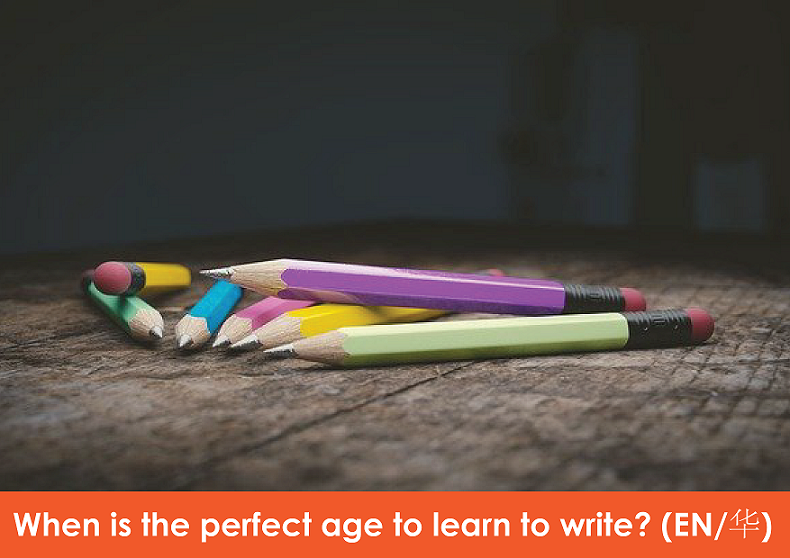
When is the perfect age to learn to write ?
В В The strength needed to learn to write mainly comes from the wrist and finger knuckles. Therefore, for children to write well, parents must first ensure that their bones are well developed and are able to support the strength needed for writing.
В В The ability to write does not solely affect childrenвҖҷs learning. In fact, there are many ways that children can learn without needing to write. Hence, getting children to learn to write and practise too much while they are still young is not a major priority.
В В It is not recommended for children to hold a pen to write before the age of 3. The most suitable age is actually after the age of 3, or even 4 years old. If the childвҖҷs bones are not mature yet but is forced to hold a pen for a long time, this can easily cause deformation in fingers or wrist. This will badly affect their fine motor skills development.
When will the child's arm muscles and knuckles be fully developed ?
В В It is probably between 7 and 9 years old. At this time, the wrist is stronger, and they do not feel tired easily or get sored hands. At this time, children can practice a lot more and not be worried about their skeletal development. Prior to this, of course, children can hold a pen to write, but not too long. You should always let their fingers do some form of different exercises so that the bones can move and will not be deformed due to long-term holding of the pen.
В В Also, parents must pay attention to your childrenвҖҷs sitting posture. Sitting posture also greatly affects children's future learning. Before adjusting childrenвҖҷs pen holding posture, parents can put more thoughts on the sitting posture. Skeletal deformities caused by poor sitting postures are difficult to remedy. However, whether the fonts are neat or not can be practiced diligently in the future after the bones are fully developed.
What activities can children under 3 years old do to assist in later writing training ?
If you want to lay a good foundation for children to write with a pen after the age of 3, parents have to spend a lot of time training their children's wrist and finger knuckles.
В
The simple activities that babies can do before the age of 3 are:
![]() Practice unscrewing the bottle cap (depending on the strength of the child, parents can loosen the cap slightly in advance)
Practice unscrewing the bottle cap (depending on the strength of the child, parents can loosen the cap slightly in advance)
![]() Rolling ball (rolling ball can train wrist and arm strength well)
Rolling ball (rolling ball can train wrist and arm strength well)
![]() Zipper (a simple zipper action is an effective activity for training finger muscles)
Zipper (a simple zipper action is an effective activity for training finger muscles)
![]() В Coins (not only do coins help flex the finger muscles, but also improve the child's concentration and accuracy. These are greatly helpful to the writing training in the future)
В Coins (not only do coins help flex the finger muscles, but also improve the child's concentration and accuracy. These are greatly helpful to the writing training in the future)
![]() Use your fingers to scribble and learn to write on some powder objects such as sand and salt (pour sand, salt or similar powder objects on a large plate, and let children write some words with their fingers, such as English letters. Such activities can make the child recognizes some simple words first without holding a pen)
Use your fingers to scribble and learn to write on some powder objects such as sand and salt (pour sand, salt or similar powder objects on a large plate, and let children write some words with their fingers, such as English letters. Such activities can make the child recognizes some simple words first without holding a pen)
![]() Stack building blocks, jigsaw puzzles, and do art and crafts (these seemingly ordinary educational activities/toys can help children develop their knuckles and wrists)
Stack building blocks, jigsaw puzzles, and do art and crafts (these seemingly ordinary educational activities/toys can help children develop their knuckles and wrists)
How can I help my child master the skills better when they just start learning to hold a pen after the age of 3 ?
В В At this age, the childвҖҷs finger muscles and joints are still developing and not fully mature. Parents are advised not to buy generic pencils. Generally, these pencils are too thin and too small, making it is difficult for children to hold them well, and it is also relatively uneasy for children to correct their pen holding posture. It is recommended that parents first introduce crayons, markers, and some larger pens, so that children can feel the pen holding posture and the angle of force. (These pens can also be used by children before they are 3 years old. Most of them are graffiti, so there is no need to correct the pen holding posture too harshly.)
В В In conclusion, it is good training for children to do more work. You will often see children who like to touch each other. In addition of bringing out their curiosity, touch is also one of the channels in which children begin to recognize the world. As long as it is still in a hygienic and safe condition, let the children touch more, do more with their hands, use fingers, wrists, and arm muscles appropriately! These are the key points for writing and practicing in the future. Once again, parents must remember not to blindly let their children learn to write with a pen. It does not mean that the earlier a child learns to write, the earlier the child starts to learn!
CLICK THE Link Below to WhatsApp Us Now or Call Us

В
е®қе®қеә”иҜҘеҮ еІҒжүҚйҖӮеҗҲеӯҰд№ еҶҷеӯ—пјҢиҝҳжІЎеӯҰд№ еҶҷеӯ—д№ӢеүҚйңҖиҰҒеҒҡдәӣеҮҶеӨҮеҗ—пјҹжҲ–иҖ…йңҖиҰҒжіЁж„Ҹдәӣд»Җд№Ҳеҗ—пјҹ
д»ҠеӨ©жҲ‘们жқҘдәҶи§Је…ідәҺе®қе®қз»ғд№ еҶҷеӯ—зҡ„зҹҘиҜҶпјҢеёҢжңӣеҜ№зҲёзҲёеҰҲеҰҲжңүеё®еҠ©гҖӮ
В
д»Җд№Ҳе№ҙйҫ„йҖӮеҗҲеӯҰеҶҷеӯ— пјҹ
еӯҰеҶҷеӯ—йңҖиҰҒзҡ„еҠӣеәҰдё»иҰҒжқҘиҮӘдәҺжүӢи…•е’ҢжүӢжҢҮжҢҮе…іиҠӮпјҢжүҖд»ҘиҰҒеӯ©еӯҗеҶҷеҘҪеӯ—е°ұеҫ—е…ҲзЎ®дҝқеӯ©еӯҗзҡ„йӘЁйӘје·Із»ҸеҸ‘иӮІжҲҗзҶҹпјҢжңүиғҪеҠӣж”ҜжҢҒеҶҷеӯ—жүҖйңҖиҰҒзҡ„еҠӣеәҰгҖӮ
еӯҰдјҡеҶҷеӯ—дёҚд»ЈиЎЁеӯ©еӯҗжүҚејҖе§ӢеӯҰд№ пјҢеңЁдёҚеҶҷеӯ—зҡ„жғ…еҶөдёӢе…¶е®һеӯ©еӯҗеҸҜд»ҘеӯҰд№ зҡ„дёңиҘҝжңүеҫҲеӨҡпјҢжүҖд»ҘдёҚиҰҒдёҖжҳ§ең°иҰҒжұӮеӯ©еӯҗеӯҰеҶҷеӯ—гҖҒз»ғеӯ—гҖӮ
3еІҒд№ӢеүҚйғҪдёҚе»әи®®еӯ©еӯҗжҸЎз¬”еҶҷеӯ—пјҢжңҖйҖӮеҗҲзҡ„е№ҙйҫ„е…¶е®һжҳҜеңЁ3еІҒд№ӢеҗҺпјҢз”ҡиҮіеҲ°4еІҒд№ҹйғҪиҝҳиЎҢгҖӮ
еҰӮжһңеӯ©еӯҗзҡ„йӘЁйӘјеңЁиҝҳжІЎеҸ‘иӮІжҲҗзҶҹеҚҙй•ҝж—¶й—ҙжҸЎз¬”еҶҷеӯ—зҡ„жғ…еҶөдёӢпјҢжҳҜе®№жҳ“еҜјиҮҙеӯ©еӯҗжүӢжҢҮеҸҳеҪўпјҢз”ҡиҮіжҳҜжңүз•ёеҪўзҡ„еҖҫеҗ‘пјҢ然иҖҢиҝҷжҳҜдјҡеҪұе“Қд»ҘеҗҺзҡ„еҗ„з§ҚеҸ‘еұ•пјҢе°Өе…¶йңҖиҰҒжүӢжҢҮжҙ»еҠЁзҡ„еҠЁдҪңйғҪдјҡеҸ—еҪұе“ҚгҖӮ
В
еӯ©еӯҗиӮўдҪ“зҡ„еҸ‘иӮІжҰӮеҶө
еӯ©еӯҗд»Җд№Ҳж—¶еҖҷжүӢиҮӮиӮҢиӮүе’ҢжҢҮе…іиҠӮеҸ‘иӮІеҒҘе…Ёпјҹ
еӨ§жҰӮжҳҜд»ӢдәҺ7иҮі9еІҒд№Ӣй—ҙпјҢиҝҷдёӘж—¶еҖҷжүӢи…•жҜ”иҫғжңүеҠӣпјҢеӯ©еӯҗдёҚе®№жҳ“и§үеҫ—жҸЎз¬”зҙҜжҲ–еҮәзҺ°жүӢй…ёзҡ„жғ…еҶөгҖӮ
иҝҷж—¶еҖҷз»ғеӯ—з»ғеҫ—еӨҡд№ҹжҜ”иҫғдёҚжӢ…еҝғйӘЁйӘјеҸ‘иӮІдёҚеҒҘе…ЁгҖӮ
еңЁиҝҷд№ӢеүҚпјҢеҪ“然еӯ©еӯҗжҳҜеҸҜд»ҘжҸЎз¬”еҶҷеӯ—зҡ„пјҢеҸӘжҳҜж—¶й—ҙдёҚиҰҒеӨӘй•ҝпјҢиҰҒж—¶еёёи®©жүӢжҢҮеҒҡдёҖдәӣдёҚдёҖж ·зҡ„иҝҗеҠЁпјҢеҘҪи®©йӘЁйӘјжҙ»еҠЁжҙ»еҠЁпјҢдёҚеӣ дёәй•ҝжңҹжҸЎз¬”е®ҡеһӢзҡ„жғ…еҶөдёӢиҖҢеҮәзҺ°з•ёеҪўгҖӮ
иҝҳжңүпјҢзҲ¶жҜҚд№ҹеҫ—жіЁж„Ҹеӯ©еӯҗзҡ„еқҗе§ҝпјҢеқҗе§ҝд№ҹжҳҜеӨ§еӨ§еҪұе“Қеӯ©еӯҗж—ҘеҗҺзҡ„еӯҰд№ гҖӮ
еңЁи°ғж•ҙеӯ©еӯҗжҸЎз¬”е§ҝеҠҝд№ӢеүҚпјҢ家й•ҝеҸҜд»Ҙж”ҫеӨҡзӮ№еҝғжҖқеңЁеқҗе§ҝдёҠгҖӮ
дёҚиүҜеқҗе§ҝеёҰжқҘзҡ„йӘЁйӘјз•ёеҪўжҳҜеҗҺеӨ©йҡҫиЎҘж•‘зҡ„пјҢ然иҖҢеӯ—дҪ“жҳҜеҗҰе·Ҙж•ҙеҫ…йӘЁйӘјеҸ‘иӮІеҒҘе…ЁеҗҺиҝҳеҸҜд»ҘеҗҺеӨ©еӢӨз»ғгҖӮ
В
еҰӮдҪ•её®еҠ©3еІҒеүҚзҡ„еӯ©еӯҗи®ӯз»ғеҶҷеӯ— пјҹ
иӢҘжғіз»ҷеӯ©еӯҗеңЁ3еІҒд»ҘеҗҺзҡ„жҸЎз¬”еҶҷеӯ—жү“еҘҪеҹәзЎҖпјҢзҲ¶жҜҚ们еҫ—иҠұеӨҡзӮ№еҝғжҖқеңЁи®ӯз»ғеӯ©еӯҗзҡ„жүӢи…•е’ҢжүӢжҢҮжҢҮе…іиҠӮгҖӮ
3еІҒд»ҘеүҚе®қе®қ们еҸҜд»ҘеҒҡзҡ„з®ҖеҚ•жҙ»еҠЁжңүпјҡ
![]() В з»ғд№ жӢ§ејҖ瓶зӣ– пјҲи§Ҷеӯ©еӯҗзҡ„еҠӣеәҰпјҢзҲ¶жҜҚеҸҜд»ҘдәӢе…ҲжҠҠ瓶зӣ–зЁҚеҫ®жқҫејҖпјү
В з»ғд№ жӢ§ејҖ瓶зӣ– пјҲи§Ҷеӯ©еӯҗзҡ„еҠӣеәҰпјҢзҲ¶жҜҚеҸҜд»ҘдәӢе…ҲжҠҠ瓶зӣ–зЁҚеҫ®жқҫејҖпјү
![]() В ж»ҡзҗғ пјҲж»ҡзҗғзҡ„еҠЁдҪңеҸҜд»ҘеҫҲеҘҪең°и®ӯз»ғи…•еҠӣеҸҠиҮӮеҠӣпјү
В ж»ҡзҗғ пјҲж»ҡзҗғзҡ„еҠЁдҪңеҸҜд»ҘеҫҲеҘҪең°и®ӯз»ғи…•еҠӣеҸҠиҮӮеҠӣпјү
![]() В жӢүжӢүй“ҫ пјҲз®ҖеҚ•зҡ„жӢүжӢүй“ҫеҠЁдҪңжҳҜи®ӯз»ғжүӢжҢҮиӮҢиӮүзҡ„жңүж•Ҳжҙ»еҠЁпјү
В жӢүжӢүй“ҫ пјҲз®ҖеҚ•зҡ„жӢүжӢүй“ҫеҠЁдҪңжҳҜи®ӯз»ғжүӢжҢҮиӮҢиӮүзҡ„жңүж•Ҳжҙ»еҠЁпјү
![]() В жҠ•й’ұеёҒ пјҲжҠ•й’ұеёҒзҡ„еҠЁдҪңдёҚдҪҶеҸҜд»ҘзҒөжҙ»жүӢжҢҮиӮҢиӮүпјҢиҝҳеҸҜд»ҘжҸҗеҚҮеӯ©еӯҗзҡ„дё“жіЁеҠӣд»ҘеҸҠзІҫеҮҶеәҰпјҢиҝҷдәӣйғҪжҳҜеҜ№еҫҖеҗҺеҶҷеӯ—и®ӯз»ғжңүеӨ§еӨ§её®еҠ©зҡ„пјү
В жҠ•й’ұеёҒ пјҲжҠ•й’ұеёҒзҡ„еҠЁдҪңдёҚдҪҶеҸҜд»ҘзҒөжҙ»жүӢжҢҮиӮҢиӮүпјҢиҝҳеҸҜд»ҘжҸҗеҚҮеӯ©еӯҗзҡ„дё“жіЁеҠӣд»ҘеҸҠзІҫеҮҶеәҰпјҢиҝҷдәӣйғҪжҳҜеҜ№еҫҖеҗҺеҶҷеӯ—и®ӯз»ғжңүеӨ§еӨ§её®еҠ©зҡ„пјү
![]() В еңЁжІҷгҖҒзӣҗзӯүдёҖдәӣзІүзҠ¶зү©дҪ“дёҠз”ЁжүӢжҢҮж¶ӮйёҰгҖҒеӯҰд№ еҶҷеӯ— пјҲжҠҠжІҷгҖҒзӣҗжҲ–зұ»дјјең°зІүзҠ¶зү©дҪ“еҖ’еңЁеӨ§зӣҳеӯҗпјҢи®©еӯ©еӯҗз”ЁжүӢжҢҮеҶҷдёҖдәӣеӯ—пјҢиӯ¬еҰӮиӢұж–Үеӯ—жҜҚпјҢиҝҷж ·зҡ„жҙ»еҠЁеҸҜд»Ҙи®©еӯ©еӯҗеңЁдёҚйңҖиҰҒжҸЎВ 笔зҡ„жғ…еҶөдёӢе…Ҳи®ӨиҜҶдёҖдәӣз®ҖеҚ•зҡ„еӯ—пјү
В еңЁжІҷгҖҒзӣҗзӯүдёҖдәӣзІүзҠ¶зү©дҪ“дёҠз”ЁжүӢжҢҮж¶ӮйёҰгҖҒеӯҰд№ еҶҷеӯ— пјҲжҠҠжІҷгҖҒзӣҗжҲ–зұ»дјјең°зІүзҠ¶зү©дҪ“еҖ’еңЁеӨ§зӣҳеӯҗпјҢи®©еӯ©еӯҗз”ЁжүӢжҢҮеҶҷдёҖдәӣеӯ—пјҢиӯ¬еҰӮиӢұж–Үеӯ—жҜҚпјҢиҝҷж ·зҡ„жҙ»еҠЁеҸҜд»Ҙи®©еӯ©еӯҗеңЁдёҚйңҖиҰҒжҸЎВ 笔зҡ„жғ…еҶөдёӢе…Ҳи®ӨиҜҶдёҖдәӣз®ҖеҚ•зҡ„еӯ—пјү
![]() В еҸ з§ҜжңЁгҖҒжӢјжӢјеӣҫгҖҒеҒҡзҫҺеҠіпјҲиҝҷдёҖдәӣзңӢдјјжҷ®йҖҡзҡ„зӣҠжҷәжҙ»еҠЁ/зҺ©е…·йғҪеҸҜд»Ҙеё®еҠ©еӯ©еӯҗжҢҮе…іиҠӮе’ҢжүӢи…•еҸ‘еұ•пјү
В еҸ з§ҜжңЁгҖҒжӢјжӢјеӣҫгҖҒеҒҡзҫҺеҠіпјҲиҝҷдёҖдәӣзңӢдјјжҷ®йҖҡзҡ„зӣҠжҷәжҙ»еҠЁ/зҺ©е…·йғҪеҸҜд»Ҙеё®еҠ©еӯ©еӯҗжҢҮе…іиҠӮе’ҢжүӢи…•еҸ‘еұ•пјү
В
еҰӮдҪ•её®еҠ©3еІҒеҗҺзҡ„еӯ©еӯҗжҺҢжҸЎжҠҖе·§пјҹ
еӯ©еӯҗеңЁиҝҷдёӘе№ҙйҫ„жүӢжҢҮиӮҢиӮүгҖҒе…іиҠӮиҝҳжҳҜеӨ„дәҺеҸ‘иӮІж—¶жңҹпјҢжңӘе®Ңе…ЁжҲҗзҶҹпјҢе»ә议家й•ҝ们дёҚиҰҒд№°дёҖиҲ¬з”Ёзҡ„铅笔гҖӮ
дёҖиҲ¬з”Ёзҡ„铅笔еӨӘз»ҶгҖҒеӨӘе°ҸпјҢеҜ№еӯ©еӯҗжқҘиҜҙжҜ”иҫғдёҚе®№жҳ“жҸЎеҘҪпјҢд№ҹзӣёеҜ№йҡҫзә жӯЈеӯ©еӯҗжҸЎз¬”зҡ„е§ҝеҠҝгҖӮ
е»ә议家й•ҝе…ҲејҖе§Ӣд»Ӣз»ҚиңЎз¬”гҖҒйәҰе…Ӣ笔пјҢдёҖдәӣжҜ”иҫғзІ—еӨ§зҡ„笔пјҢи®©еӯ©еӯҗе…Ҳж„ҹеҸ—дёҖдёӢжҸЎз¬”е§ҝеҠҝе’Ңз”ЁеҠӣзҡ„и§’еәҰгҖӮ
пјҲиҝҷдёҖдәӣ笔д№ҹеҸҜд»ҘеңЁеӯ©еӯҗ3еІҒеүҚ让他们е°қиҜ•дҪҝз”ЁпјҢеӨҡдёәж¶ӮйёҰпјҢдёҚеҝ…иҝҮеҲҶдёҘиӢӣең°зә жӯЈжҸЎз¬”е§ҝеҠҝгҖӮпјү
В
жҖ»з»“пјҡ и®©еӯ©еӯҗеӨҡеҠЁжүӢжҳҜеҫҲеҘҪзҡ„и®ӯз»ғ
дҪ дјҡеёёеёёзңӢеҲ°еӯ©еӯҗе–ңж¬ўдёңж‘ёиҘҝж‘ёзҡ„пјҢйҷӨдәҶеҮәдәҺеҘҪеҘҮд»ҘеӨ–пјҢи§Ұж‘ёд№ҹжҳҜеӯ©еӯҗејҖе§ӢеҜ№иҝҷдёӘдё–з•Ңдә§з”ҹи®ӨзҹҘзҡ„е…¶дёӯдёҖдёӘз®ЎйҒ“гҖӮ
еҸӘиҰҒиҝҳеӨ„дәҺеҚ«з”ҹгҖҒе®үе…Ёзҡ„жғ…еҶөдёӢпјҢи®©еӯ©еӯҗеӨҡи§Ұж‘ёгҖҒеӨҡеҠЁжүӢгҖҒйҖӮеҪ“зҡ„дҪҝз”ЁжүӢжҢҮгҖҒжүӢи…•гҖҒжүӢиҮӮзҡ„иӮҢиӮүеҗ§пјҒ
иҝҷдәӣйғҪжҳҜж—ҘеҗҺеҶҷеӯ—гҖҒз»ғеӯ—зҡ„е…ій”®зӮ№гҖӮ
еҶҚж¬Ўејәи°ғпјҢзҲ¶жҜҚ们еҲҮи®°дёҚиҰҒзӣІзӣ®ең°и®©еӯ©еӯҗеӯҰд№ жҸЎз¬”еҶҷеӯ—пјҢдёҚжҳҜеӯ©еӯҗи¶Ҡж—©еӯҰдјҡеҶҷеӯ—жүҚд»ЈиЎЁеӯ©еӯҗејҖе§ӢеӯҰд№ е“ҰпјҒ
В
CLICK THE Link Below to WhatsApp Us Now or Call Us



